Dog Collars 1930 Fashion Dog Collars 1940 Fashion
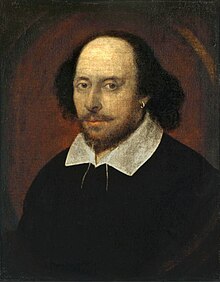
William Shakespeare in a sheer linen collar of the early on 17th century, a direct ancestor of the modern shirt collar.
In clothing, a collar is the part of a shirt, apparel, coat or blouse that fastens around or frames the neck. Amongst clothing construction professionals, a collar is differentiated from other necklines such equally revers and lapels, past being made from a split piece of fabric, rather than a folded or cutting function of the same piece of fabric used for the main trunk of the garment.
A neckband may exist permanently attached to the primary torso of the garment (e.k. by stitching) or detachable.
Discussion usage [edit]
The Oxford English Dictionary traces collar in its mod significant to c. 1300, when collars served as cervix-protecting armour.[1]
History [edit]
Today's shirt collars descend from the rectangular ring of linen around the neck of 16th century shirts. Separate ruffs exist aslope attached ruffled collars from the mid-16th century, unremarkably to allow starching and other fine finishing,[ citation needed ] or to make collar-laundering easier.[2]
During the medieval period and sporadically thereafter, people wore ornamental collars every bit a form of jewelry.
Terminology [edit]
- Band – a strip of cloth that fastens effectually the cervix, perpendicular to the body of the garment, to which a collar proper may be attached.
- Collar stiffeners, basic or stays – strips of baleen, metal, horn, mother of pearl, or plastic, rounded at one end and pointed at the other, inserted into a man's shirt neckband to stiffen information technology and prevent the points from crimper up; usually inserted into the underside of the collar through small slits but sometimes permanently sewn in place.
- Points – the corners of a neckband; in a buttoned-down neckband, the points are fitted with buttonholes that adhere to minor buttons on the torso of the shirt to agree the collar neatly in identify.
- Spread – the distance between the points of a shirt collar.
- Stand – the band on a glaze or shirt collar that supports the collar itself.
Types [edit]
Collars tin can exist categorized every bit:
- Standing or stand-up, fitting up effectually the neck and non lying on the shoulders.
- Turnover, standing effectually the neck so folded or rolled over.
- Apartment or falling, lying flat on the shoulders.
Collars may too be stiffened, traditionally with starch; modernistic launder-and-wear shirt collars may be stiffened with interfacing or may include metal or plastic collar stays. Shirt collars which are not starched are described as soft collars. The shape of collars is also controlled by the shape of the neckline to which they are attached. Most collars are fitted to a jewel neck, a neckline sitting at the base of the cervix all around; if the garment opens downwardly the front, the top edges may be folded back to class lapels and a Five-shaped opening, and the cut of the neckband will be adapted accordingly.
Collar styles [edit]
Names for specific styles of collars vary with the vagaries of fashion. In the 1930s and 1940s, especially, historical styles were adapted by mode designers; thus, the Victorian bertha neckband — a cape-like neckband fitted to a low scooping neckline — was adapted in the 1940s but more often than not fastened to a V-neckline.
Some specific styles of collars include:
| Blazon | Other names | Epitome | Information |
|---|---|---|---|
| Ascot collar | stock collar | A very tall standing collar with the points turned up over the chin, to exist worn with an Ascot necktie. | |
| Albany collar | A standard turndown cutaway neckband, worn predominantly in the early on 20th century. | ||
| Band | Grandad collar |  | A neckband with a modest standing band, usually buttoned, in the manner worn with detachable collars. |
| Barrymore collar |  | A turnover shirt neckband with long points, as worn by the thespian John Barrymore. The style reappeared in the 1970s; particularly during that time it was frequently known as a "tapered collar," and could accompany fashionable wide four-in-hand neckties on wearing apparel shirts. | |
| Bertha collar |  | A wide, flat, round neckband, often of lace or sheer material, worn with a low neckline in the Victorian era and resurrected in the 1940s. | |
| Buster Brown collar |  | A wide, apartment, circular neckband, sometimes with a ruffle, usually worn with a floppy bow tie, characteristic of boys' shirts from c. 1880–1920. | |
| Butterfly neckband | The same equally the wing neckband, but with rounded tips. Popularised by fictional detective Hercule Poirot. | ||
| Push-down neckband |  | A collar with buttonholes on the points to fasten them to the trunk of the shirt. | |
| Camp collar | convertible collar, notched collar | A jumpsuit collar that lies flat, part of the shirt too lies apartment to create a notch. | |
| Cape collar | A collar fashioned like a cape and hanging over the shoulders. | ||
| Chelsea collar | A woman's neckband for a low V-neckline, with a stand and long points, popular in the 1960s and 1970s. | ||
| Clerical neckband | 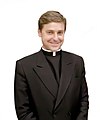 | A ring collar worn as role of clerical habiliment. | |
| Convertible collar | A collar designed to be worn with the neck push button either fastened or unfastened. | ||
| Cossack collar | A high continuing neckband opening to one side and frequently trimmed with embroidery; popular under the influence of the 1965 moving picture Doctor Zhivago. | ||
| Detachable collar | false-collar |  | A collar fabricated as a separate accompaniment to be worn with a band-collared shirt. (Currently worn styles are turndown, tab, and dog collars; as well as historical styles such as Imperial or Gladstone.) |
| Double Round Collar | A reject collar with rounded tips. | ||
| Edwardian Neckband | A high strong collar such every bit the Canadian hockey commentator/glory Don Cherry wears. The opposite of slovenly, only not actually formal. | ||
| Eton neckband | 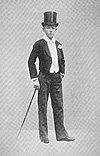 | A wide stiff buttoned neckband forming part of the uniform of Eton College starting in the belatedly 19th century. | |
| Falling band | A collar with rectangular points falling over the chest, worn in the 17th century and remaining part of Anglican clerical clothing into the 19th century. | ||
| Fichu collar | A collar styled similar an 18th-century fichu, a large neckerchief folded into a triangular shape and worn with the point in the dorsum and the front corners tied over the breast. | ||
| Gladstone neckband |  | A standing collar with the points pressed to stick out horizontally at the side-fronts, worn with a scarf or ascot; popularized past the British Prime Government minister William Ewart Gladstone. | |
| High neck collar | 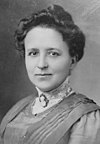 | A collar that covers all or most of the neck, popular among women in Edwardian times. | |
| HRH collar | Stand-up turned-down neckband | 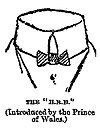 | A shirt collar created[3] past Charvet for Edward 7, which became very pop[4] at the end of the 19th century. |
| Imperial/Poke collar | A stiff continuing collar for men's formal wear, differentiated from other tall styles by the lack of tabs at the forepart. | ||
| Italian collar | A collar on men's shirts in which the upper neckband is part of the shirt facing and the undercollar is a split up slice.[5] | ||
| Jabot collar | 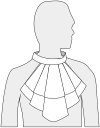 | A standing collar with a pleated, ruffled, or lace-trimmed frill downward the front. | |
| Johnny collar | A fashion with an open, brusk Five-cervix and a apartment, often knit collar. | ||
| Kent collar |  | One of the most frequent contemporary collar styles. | |
| Lacoste collar | the un-starched, apartment, protruding neckband of a tennis shirt, invented past René Lacoste. | ||
| Long signal collar | Directly point collar, Forward betoken collar, Narrow point collar |  | A collar with long pointy edges. Usually worn with a adapt and a tie, because otherwise the extra long collar points can look odd. It'due south considered a conservative type of neckband. |
| Mandarin | Cadet collar, Chinese collar | 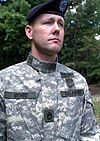 | A small standing collar, open at the front end, based on traditional Manchu or Mongol-influenced Asian garments. |
| Man-tailored neckband | A woman's shirt neckband made like a man's shirt collar with a stand up and stiffened or buttoned-down points. | ||
| Mao collar |  | A curt, almost straight standing collar folded over, with the points extending only to the base of operations of the band, characteristic of the Mao conform. | |
| Masonic collar [6] |  | A detachable collar made of fabric or chains that is worn by Freemasons of high rank or office. It signifies which office they hold. A jewel is attached to the bottom of the collar farther defining the Brothers rank and part. Also see photo of NSW & Deed Grand Master wearing his collar.[6] | |
| Medici collar |  | A flared, fan-shaped neckband standing high behind the head, often of lace, in the manner seen in portraits of Marie de' Medici.[7] | |
| Middy collar | 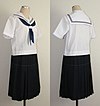 | A sailor collar (from midshipman), pop for women's and children'southward article of clothing in the early 20th century. | |
| Mock | mockneck |  | A knitted collar similar to a turtleneck, but without a turnover. |
| Napoleonic collar | So chosen considering of its association with Emperor Napoleon I Bonaparte'due south military uniforms. A turnover collar, fairly rigid in construction and open at the front, it is similar to a Nehru collar, but it rises much higher and is generally shaped to frame the wearer'southward neck and lower head; this was a design feature that William Belew incorporated into Elvis Presley'southward "stage uniforms" in his later years. | ||
| Nehru collar |  | A small continuing neckband, meeting at the forepart, based on traditional Indian garments, popular in the 1960s with the Nehru jacket. | |
| Notched collar |  | A wing-shaped collar with a triangular notch in it, with the lapels (when on blazers and jackets) of a garment at the seam where collar and lapels. Often seen in blazers and blouses with business suits. Likewise, rounded notched collars appear in many forms of pajamas and nurses uniforms.[eight] | |
| Peter Pan collar | 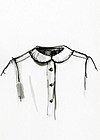 | A apartment, round-cornered collar, named subsequently the collar of the costume worn in 1905 by extra Maude Adams in her role as Peter Pan, and particularly associated with little girls' dresses.[9] | |
| Piccadilly neckband | A fly collar made of plastic or celluloid. | ||
| Pierrot collar | 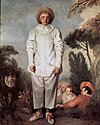 | A round, flat, limp collar based on the costume worn by the Commedia dell'Arte character Pierrot. | |
| Poet collar | 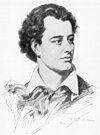 | A soft shirt collar, often with long points, worn past Romantic poets such as Lord Byron, or a 1970s style reminiscent of this. | |
| Popped neckband | A style of wearing a collar unfolded and high confronting the neck, made pop in the early on 1980s with polo shirts. Saw a resurgence in the 2000s with bro culture. | ||
| Pussy bow | A collar tied in a large bow under the wearer's chin. Particularly associated with Margaret Thatcher in the 1980s.[10] | ||
| Rabat | 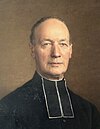 | Clerical Collar worn in the Catholic Church for hundreds of years, the Rabat does not equal the ordinary bands of a gauge. | |
| Revere collar | A flat V-shaped neckband oftentimes establish on blouses. | ||
| Rolled collar | Any neckband that is softly rolled where it folds downward from the stand, as opposed to a collar with a pressed crease at the fold. | ||
| Round neckband | Any collar with rounded points. | ||
| Ruff collar |  | A high standing pleated collar pop in the renaissance period fabricated of starched linen or lace, or a similar manner popular late seventeenth century and again in the early nineteenth century. They were also known every bit "millstone collars" after their shape.[11] | |
| Sailor collar | 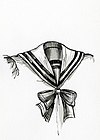 | A collar with a deep 5-cervix in front, no stand, and a square dorsum, based on traditional sailor's uniforms. | |
| Shawl collar |  | A round collar for a V-neckline that is extended to form lapels, often used on cardigan sweaters, dinner jackets and women'south blouses. | |
| Spread collar | cutting away collar |  | A shirt collar with a wide spread betwixt the points, which can accommodate a bulky necktie knot. |
| Tab collar | A shirt neckband with a small tab that fastens the points together underneath the knot of the necktie. | ||
| Tunic neckband | A shirt neckband with only a brusk (ane cm) standing ring around the neck, with holes to fasten a detachable neckband using shirt studs. | ||
| Tunisian collar | A "T" shaped collar with a vertical button placket going up to mid-chest. This blazon of neckband is believed to originate from the Jebba, a Tunisian Folk costume. This type of collar is currently in utilise for modern shirts and pulls. Besides the Jebba is still worn in Tunisia every bit a ceremonial traditional costume. | ||
| Turned-Down Collar |  | A folded collar pointing downward, as opposed to a turned-up collar, such as a Wing collar; created by Charvet.[12] | |
| Turtleneck | polo neck, rollneck, skivvy |  | A close-fitting knitted collar that folds over and covers the cervix |
| Upturned collar |  | An otherwise flat, protruding neckband of either a shirt (especially a tennis shirt), jacket, or coat that has been turned upwardly, either for sport employ, warmth, or every bit either a "fashion indicate" or a perceived status symbol. Elvis Presley favored this collar style, peculiarly in the earliest years of his career, because he believed his neck looked besides long; he had, in plow, been inspired by Baton "Mr. B" Eckstine, who had designed and patented a high curlicue collar that formed a "B" over a double Windsor-knotted necktie. | |
| Van Dyke | vandyke collar |  | A large collar with deep points standing loftier on the neck and falling onto the shoulders, usually trimmed with lace or reticella, worn in the second quarter of the 17th century, every bit seen in portraits by Anthony van Dyck. The vandyke collar was also popular in the United States in the 1880s.[13] |
| Windsor collar |  | For a cutaway neckband: a dress-shirt collar that is slightly stiff, with a wide spread (infinite between the points) to accommodate a Windsor knot tie, popularized in the 1930s; for a fly collar, a standard wing neckband. | |
| Wing collar | wingtip collar |  | A small standing collar with the points pressed to stick out horizontally, resembling "wings," worn with men's evening clothes (white tie or black necktie); a descendant of Gladstone neckband. Used by barristers in the U.k., Canada and India. |
| Fly | whisk | A stiffened one-half-circle collar with a tall stand up, worn in the early on 17th century. | |
| Y-collar | Similar to a Johnny neckband, only with one or 2 buttons at the bottom of the V-cervix line, creating a "Y" shape. | ||
| Zero collar |  | Neckline of shirt without band and neckband. |
Buttoning [edit]
Conventions on fastening the buttons on a neckband differ globally. In the United States and the U.k., the top button is virtually e'er left unbuttoned, unless one is wearing a tie, but unbuttoning two or more buttons is seen as overly casual. By contrast, in Slavic countries, including at least Poland, and Ukraine, the top button is buttoned fifty-fifty in the absence of a tie.
Extended meanings [edit]
From the dissimilarity between the starched white shirt collars worn by businessmen in the early 20th century and the blue chambray workshirts worn by laborers comes the use of collar colors in job designation, the "workforce colorwheel". Examples are blue-collar, pink-collar and white-collar.
See likewise [edit]
- Camp shirt
- Chemise
- Collar (BDSM)
- Collar stays
- Detachable collar
- Apparel shirt
- Neckline
- Tie
- Polo neck
- Reticella
- Ruff
- Shirt
- Upturned collar
References [edit]
- ^ Harper, Douglas. "collar". Online Etymology Lexicon.
- ^ Compare: Skipper, H. R. (1928). "six: Outfitting: Collars By and Present". In Bridgland, A. S. (ed.). The Mod Tailor Outfitter and Clothier. Vol. 3. Read Books Ltd (published 2013). p. half dozen. ISBN9781447497967. Archived from the original on 2019-12-21. Retrieved 2018-01-08 .
It is claimed by America that one of her citizens, a Mrs. Hannah Lord Montague, in the course of her domestic duties a hundred years ago, observed that collars (which in those days were part of the shirt) soiled much more than chop-chop than the balance of the garment. She conceived the thought of making a collar which could exist discrete from the shirt and washed separately. Whether the detachable collar originated in America or non, the collar industry in England seems to have come into beingness in 1840, more than or less near the same fourth dimension as information technology did in America.
- ^ "Attempt our "98'Curzons!" A few fashion hints for men". Otago Witness. Nov 3, 1898. Archived from the original on September 15, 2012. Retrieved 2010-01-26 .
It was really the Prince of Wales who introduced this shape. He got them originally about eight years ago from a manufacturer called Charvet, in Paris.
- ^ Levitt, Sarah (1991). Way in photographs 1880–1900. London: Batsford. p. 81. ISBN0-7134-6120-9.
- ^ Lappin, Peter (August 2020). "Patterns of the By: Exploring the Early 1960s Italian Neckband Shirt". Threads.
- ^ a b "Freemasons NSW & ACT – The Grand Master". www.masons.org.au. Archived from the original on 2015-12-23. Retrieved 2014-05-27 .
- ^ Cumming, Valerie (2010). The dictionary of manner history. Oxford New York: Berg. p. 130. ISBN9781847885333.
- ^ "- Define at Dictionary.com". world wide web.dictionary.com.
- ^ Felsenthal, Julia (20 January 2012). "Where the Peter Pan Collar Came From—and Why It'south Dorsum". Slate Mag. Archived from the original on 21 January 2012. Retrieved 21 January 2012.
- ^ Carnegy, Vicky (2007). The 1980s. New York: Infobase Pub. p. vii. ISBN978-1438118949. Archived from the original on 2019-12-25. Retrieved 2016-11-07 .
- ^ "Collar of Linen and Needle Lace, anonymous, c. 1625 – c. 1640 – Rijksmuseum". Archived from the original on 2012-x-eleven. Retrieved 2011-01-22 .
- ^ Flusser, Alan (October 1982). "The Shirt Maker". TWA Ambassador.
- ^ Trenton Country Gazette (New Bailiwick of jersey), Nov 18, 1880, p. 3; "Fashion Hints", San Francisco Bulletin, October 29, 1881, Supplement p. [2]; "Overnice Ideas and Pretty Things Women Who Blindly Follow Mode'south Leaders and Women Who Do Not", Omaha Daily Herald, p. 5; "Style Notes. Latest Styles", Baltimore Sun, August 31, 1885, Supplement p. [two].
External links [edit]
![]() Media related to Collars at Wikimedia Eatables
Media related to Collars at Wikimedia Eatables
| | Look upward neckband in Wiktionary, the free lexicon. |
- Collars on Boys Shirts and Blouses: From the Historical Boys' Wearable website



0 Response to "Dog Collars 1930 Fashion Dog Collars 1940 Fashion"
Post a Comment